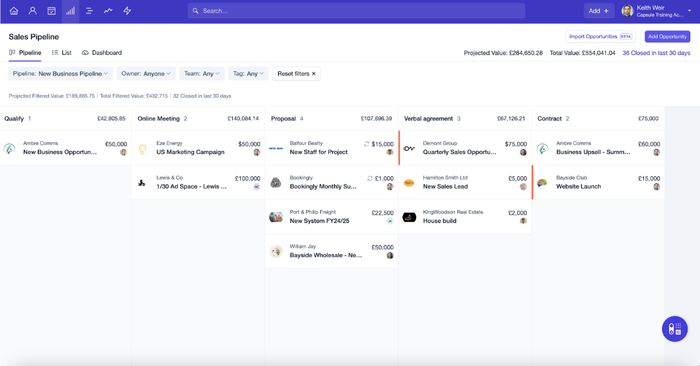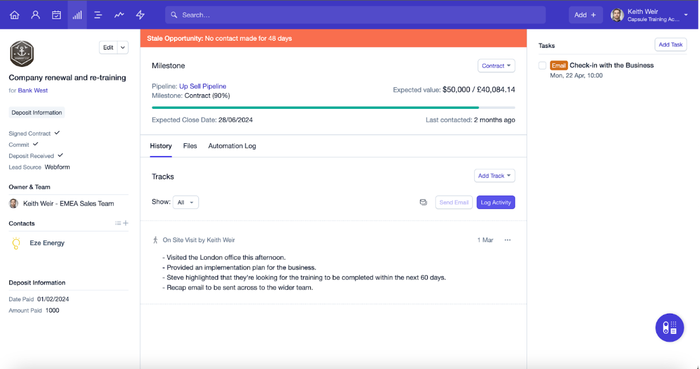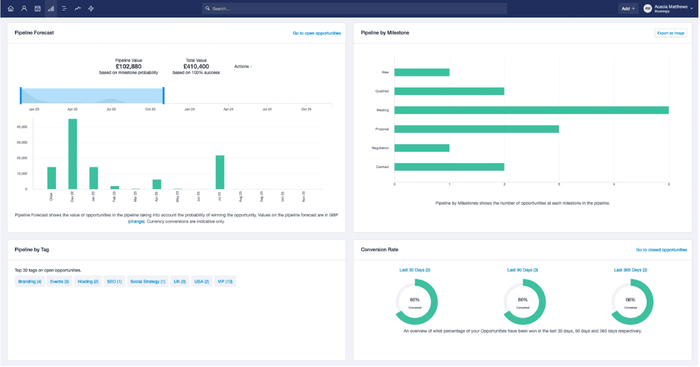Managing a small business comes with plenty of challenges. You often have to make do with limited resources, and it’s not unusual for staff to take on multiple roles and responsibilities. This can all take a toll on the different processes and procedures, meaning many small businesses lack a systematic approach to managing their sales leads.
This lack of structure often results in lost leads, missed follow-ups and ultimately reduced revenue. You can easily find yourself constantly putting out fires, trying to track down leads and struggling to maintain momentum in your sales.
Implementing a well-structured sales pipeline gives you the organization and clarity needed to manage your leads effectively.
In this article, we’ll explore the best practices for creating a sales pipeline, with a step-by-step guide to help your small business capture, nurture and convert leads more effectively.
Understanding sales pipelines for small businesses
First of all, what exactly is a sales pipeline? The pipeline visually represents where your prospects are in the sales process. It outlines each stage a potential customer goes through, from initial contact to final purchase.
Think of your sales pipeline as a roadmap that guides your sales team, helping them stay organized and focused on efficiently moving leads through the buying journey.
For small businesses, a well-managed sales pipeline allows you to:
- Monitor the status of each lead and understand where they are in the buying process.
- Identify bottlenecks where leads are getting stuck (so you can smooth them out)
- Forecast sales and revenue more accurately by analyzing the pipeline’s health and dynamics
- Improve efficiency to ensure your team spends time on the most promising leads.
The exact stages within the pipeline can vary depending on your business and your process. The default pipeline stages within Capsule are:
- New. At this stage, potential customers have just entered your pipeline. They may have found you through marketing efforts, word of mouth or other channels.
- Qualified. Prospects are evaluated to determine if they fit your ideal customer profile (ICP) and are genuinely interested in your solution. This stage involves initial contact and qualification criteria to ensure they’re worth pursuing.
- Meeting. You’ve scheduled a meeting or demo with the qualified lead to discuss their needs in more detail and develop the relationship.
- Proposal. You’ve presented a proposal tailored to the prospect’s requirements that you uncovered in the meeting, outlining your solution, pricing and terms.
- Negotiation. After the prospect has reviewed the proposal, they’ll likely have some questions or requests. This stage involves negotiating terms and addressing any objections to reach a mutually beneficial agreement.
- Contract. Once negotiations are complete, the final contract is prepared and signed. This stage marks the official start of your business relationship. Congratulations!
These stages are ideal for most sales teams, and can easily be customized if you use additional or different steps in your process.

Key strategies for an effective sales pipeline
Simply having a defined sales pipeline in place makes it easier for your sales teams to track and manage prospects as they move through the sales funnel. However, by following these strategies, small businesses can get even more out of their sales pipeline.
Identify your target market
Your sales pipeline will work best when you understand your customers’ journey. The first step is to create detailed ideal customer profiles (ICPs) and buyer personas. For your personas, include details like:
- Demographics
- Pain points
- Buying behaviors
- Communication preferences.
Your personas should be based on facts, not gut feelings, if they will be useful. Conduct research to uncover the challenges and needs of your target market. This can be achieved through surveys, interviews and analyzing customer feedback. Addressing these pain points in your sales approach can significantly increase engagement and conversion rates throughout the pipeline.
Creating a sales process
Once you know your customers, you’re in a far better position to create a process tailored to them. In turn, a standardized sales process introduces consistency and efficiency across your sales team as prospects move through the pipeline.
We’re going to take a closer look at establishing clear steps and actions for each stage of the pipeline later, but the underlying strategy is to know the process and ensure your sales team knows how to most effectively carry out that process.
Create standardized scripts and email templates for common sales interactions. For example, you might have set messaging for your initial outreach that appeals to those pain points you uncovered. You can make a templated proposal for your most popular services that can then be easily customized depending on your prospect’s specific requirements. This means your sales team can deliver a consistent message and saves them time on repetitive tasks.
Choosing the right CRM tools
A robust customer relationship management (CRM) system enables you to effectively manage every aspect of your sales pipeline, from initial setup to ongoing maintenance and optimizations.
There are plenty of CRMs to choose from, so take the time to find one that fits your unique needs as a small business. Look out for CRM with a user-friendly interface that lets you get up and running as quickly as possible, as well as one that scales with your business as it grows.
Certain features are particularly useful when it comes to setting up sales pipelines. For example, Capsule CRM comes with sales tracking, workflow automation, analytics and integrations for your other favorite tools. These features help streamline processes and provide valuable insights into your pipeline’s performance.
How to build a sales pipeline for your small business
Building an effective sales pipeline involves more than just mapping out stages; it requires careful planning and ongoing optimization. Here are five key steps to help you create a robust sales pipeline tailored to your small business.
Step 1: Define your sales stages
The first step in building your sales pipeline is defining the stages a lead will go through, from initial contact to closing the deal. Analyze your sales process and identify the key milestones. What steps does every prospect have to go through before they become a customer?
While Capsule’s default stages are a great starting point, you might consider alternative stages that better fit your specific sales process and customer journey.
For example, you might use:
- Engaged. Leads that have responded positively to your initial contact and are engaging with your content or sales team.
- Follow-up. Prospects that are in the follow-up phase after the initial presentation and require additional information, but haven’t officially entered a formal negotiation stage.
- Verbal commitment. Leads that have given a verbal agreement to proceed but haven’t yet signed a contract.
- Closed-won. Prospects that have officially become customers after signing the contract and making a purchase.
- Closed-lost. Leads that have decided not to move forward with your offering.
By defining your sales stages based on your unique sales process and customer journey, you can create a more accurate and effective pipeline that reflects how your business operates.
Step 2: Customize your pipeline
With the main stages in place, you can now tailor the different parts of your pipeline to fit the unique aspects of your sales process and industry. This customization ensures that your pipeline is aligned with how your business operates and how your customers make purchasing decisions.
Where you offer a solution with little variation, you’ll likely be able to use one. However, if you offer significantly different products or services, you might find it easier to work with multiple sales pipelines with different milestones.
In either case, you can set up different tags for your pipeline, ideal for segmenting your opportunities and tracking them through the process. Use clear and descriptive names for each tag to ensure everyone on your team can easily follow leads through the pipeline.

Step 3: Define criteria for each stage
Understanding exactly when to move leads from one stage to the next helps maintain consistency and efficiency in your sales process. Establish specific, measurable criteria for each stage to ensure that leads are appropriately qualified before advancing.
For example, to move from the “New” stage to the “Qualified” stage, criteria could include showing interest by filling out a web form, subscribing to your newsletter or downloading a resource from your site.
You’ll typically expect higher engagement before moving a qualified lead onto the “Meeting” stage, so criteria here might involve responding to one of your follow-up emails, having a phone conversation regarding their current requirements or requesting product specifications.
This is also a good time to think about how you’ll identify stalled deals. For example, Capsule can automatically flag opportunities that haven’t been contacted in a set amount of time (customizable to each milestone). You can then use this to quickly spot potential leads who need a follow-up.

Step 4: Add relevant tasks and automation
As we’ve touched on, resources are often scarce in small businesses. Anything you can do to make work easier for you and your team is worth investigating.
To start with, everyone should know exactly what they’re meant to be doing at any given time. Rather than just assuming that someone will decide to follow up on that new lead or prepare a proposal, assign tasks to your team members. Capsule’s Tracks feature lets you create a templated task list for each milestone, so everyone is clear on next actions.
It’s likely your team is spending a lot of time on tasks that could be automated. Use your CRM and other automation tools to handle repetitive tasks, such as sending follow-up emails, scheduling meetings and tracking interactions. With Capsule’s Growth plan, you can automatically kick off your Track task list when those stage criteria are met, saving time and keeping leads moving through the pipeline.

Step 5: Monitor and optimize pipeline performance
When it comes to sales pipelines, it’s not a case of “set it and forget it”. To keep your pipeline operating at its best, you’ll need to regularly monitor its performance to spot any bottlenecks or areas for improvement.
Use your CRM’s analytics and reporting to keep an eye on relevant sales metrics such as conversion rates, average time spent in each stage and pipeline velocity to understand how well your pipeline is performing.

Along with ongoing monitoring, schedule regular reviews of your sales pipeline to identify any issues and make data-driven adjustments. This is a great time to get your sales team involved, so you can get first-hand feedback on their challenges as well as suggestions for improvement.
Use these insights from your reviews to continuously optimize your sales pipeline. This might involve refining your criteria, adjusting stages, or implementing new automation tools to enhance efficiency.
Strong sales pipelines for a stronger business
Building an effective sales pipeline is essential for small businesses to streamline their sales processes and drive growth. By understanding your target audience, defining clear sales stages and using the right tools for the job, you can create a strong framework that supports your business goals.
A well-defined pipeline helps visualize your sales process, ensuring leads are properly nurtured and guided toward a purchase. With these strategies, your sales pipeline can convert leads into loyal customers and drive long-term growth.
Discover how a CRM can help you grow your small business. Enjoy Capsule’s free starter package or start a 14-day free trial and see how Capsule’s features can help you break down silos and unite your teams.




